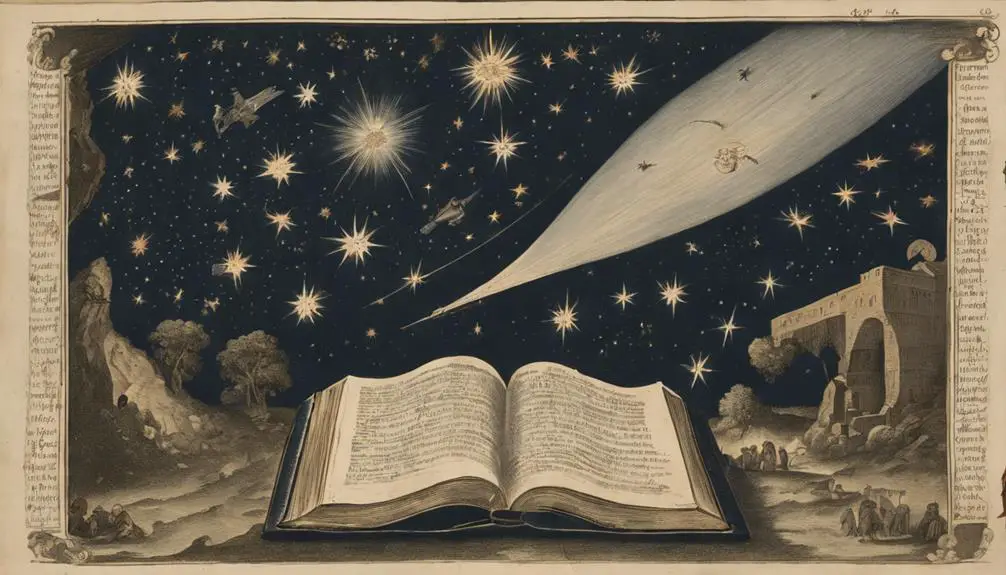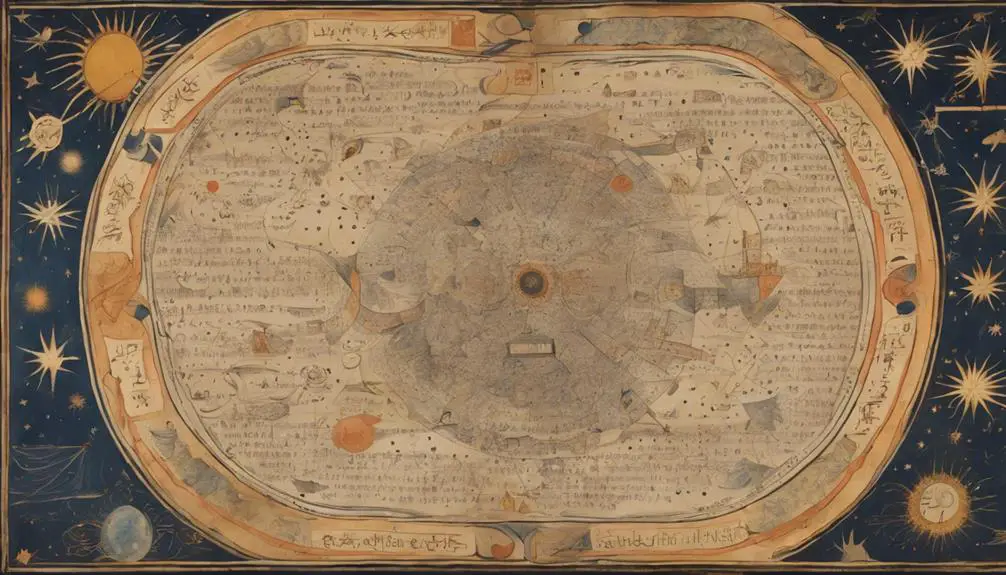Biblical wandering stars hold mystifying secrets; discover their profound significance in scripture and how they illuminate our understanding of the divine.

Wandering Stars in the Bible
Just as wandering stars in the night sky serve as symbols of mystery and uncertainty, so too does the Bible use this term in a similar, enigmatic fashion.
You might wonder, what is the significance of these 'wandering stars' in the scriptures?
They're mentioned in the book of Jude, but is there more to it? Is it a metaphor, a prophecy, or a historical reference?
Let's unpack this together, to unravel the deeper meanings behind this celestial metaphor in the Bible.
Key Takeaways
- 'Wandering Stars' in the Bible metaphorically represent spiritual deviation and disruption, often linked to false teachers or evil spirits.
- Biblical prophecies use 'Wandering Stars' as divine signals, marking significant events in spiritual history like Christ's birth and return.
- Historically, 'Wandering Stars' influenced cultural understandings of divinity, navigation, and timekeeping, reinforcing celestial reverence in spiritual beliefs.
- Modern interpretation aligns 'Wandering Stars' with planets, highlighting the divine order in the cosmos and bridging spirituality with scientific understanding.
Biblical References to 'Wandering Stars

Delving into the scriptures, you'll encounter the term 'wandering stars' used metaphorically, particularly in the New Testament, to denote certain elements of spiritual significance. The most explicit reference occurs in the Book of Jude, where these celestial objects are associated with false teachers leading people astray.
Understanding this metaphor, you must consider the astronomical context. Traditionally, 'wandering stars' referred to the five visible planets of antiquity, which moved differently from fixed stars in the sky. This erratic movement, unpredictable to ancient observers, offered a fitting symbol for those who deviated from the spiritual path.
In the historical depictions, these 'wandering stars' were often portrayed negatively. The ancients saw their wandering as a deviation from the established heavenly order. This sense of disorder and chaos correlated with the spiritual connotation in the scriptures, where 'wandering stars' were used to describe those who veered from the true teachings, causing spiritual chaos.
Symbolism of 'Wandering Stars
In unraveling the symbolism of 'wandering stars', you'll find a profound representation of spiritual deviation and disruption. These entities, moving unpredictably across the cosmos, aren't anchored to a fixed path like other celestial bodies. This erratic behavior mirrors a spiritual journey that's derailed, straying from the ordained divine path.
Star symbolism in biblical texts often represents spiritual beings or forces. Thus, 'wandering stars' can be interpreted as fallen angels or evil spirits that have deviated from their God-given purpose, causing chaos and spiritual turmoil. They're anomalies amidst the divinely ordered universe, reflecting the disruption they bring.
Planetary theology further deepens this interpretation. In ancient times, planets were considered 'wandering stars' due to their unique motions against the backdrop of fixed stars. Their unpredictable movements were seen as contrary to the divine order, symbolizing rebellion against God's will. They embodied a spiritual warning, cautioning against deviation and encouraging steadfastness in faith.
Wandering Stars' in Prophecies

Building on this understanding of wandering stars as spiritual disruptors, let's turn our attention to their role in biblical prophecies. Their appearance often signifies a foretold event's commencement, echoing the delicate interplay between prophecy fulfillment and astrological significance.
Consider the table below, which outlines key prophetic instances where wandering stars have played pivotal roles:
Prophecy |
Wandering Star |
Significance |
|---|---|---|
Birth of Jesus |
Star of Bethlehem |
The magi were guided by this star to the location of Jesus' birth. |
End Times |
Wormwood (Revelation 8:10-11) |
A star named Wormwood was prophesied to fall from the sky, causing a third of the waters to become bitter. |
Second Coming |
Sign of the Son of Man (Matthew 24:30) |
A sign in the heavens will appear, which could be a star, signalling Christ's return. |
In each case, you can see how the wandering stars aren't just celestial phenomena; they're divine signals, markers on the timeline of prophecy fulfillment. So, as you delve deeper into biblical prophecy, don't overlook the wandering stars. They have a celestial story to tell, a story steeped in spiritual significance and divine purpose.
Cultural Impact of 'Wandering Stars

Beyond their prophetic relevance, wandering stars have also had a significant impact on various cultures and their understanding of divinity and celestial events. These celestial bodies have woven themselves into the fabric of many societies, influencing their mythology, religious practices, and philosophical perspectives.
Star navigation, for example, was a direct result of our ancestors' fascination with these celestial nomads. Maritime cultures learned to navigate the vast oceans by observing the predictable movements of these celestial bodies. They didn't just see clusters of light in the night sky but instead, they saw divine guides. Their understanding of these wandering stars defined their world, their place in it, and their destiny.
The astronomical impacts of the wandering stars are also significant. They've been used to mark time, predict seasons, and navigate the globe. They've played a role in the development of calendars and in shaping agricultural practices. These influences are intertwined with the spiritual and religious beliefs of many cultures, reinforcing their reverence for these celestial bodies.
Interpreting 'Wandering Stars' Today

While the historical and cultural significance of wandering stars is profound, let's shift our focus to their interpretation in the contemporary context, where they continue to inspire awe and scientific inquiry. In the realm of Modern Astronomy, 'wandering stars' are no longer mystical entities, but recognized as planets. These planets, or 'wandering stars', have defined paths – their Planetary Movement – around the sun, a phenomenon explained by gravitational pull and celestial physics.
You might wonder how this scientific understanding intersects with the biblical notion of 'wandering stars'. Theologically, these celestial bodies serve as a testament to the divine order and design of our universe. Their predictable movement reflects a universe governed by laws and principles, which in turn, point towards a Creator with an inherent sense of order and precision.
Observing these wandering stars, you're not just seeing planets move. You're witnessing a cosmic dance that echoes the divine. So, while Modern Astronomy can explain the mechanics of Planetary Movement, it doesn't negate the spiritual significance, rather it deepens our appreciation of the divine order in the universe. Hence, today's interpretation of 'wandering stars' is a harmonious blend of science and spirituality.
Frequently Asked Questions
What Are the Scientific Explanations for 'Wandering Stars'?
You're probably curious about the scientific explanations for 'wandering stars'.
In astronomy, these are planets that move across our sky, differing from stars which remain stationary. Ancient folks misunderstood them as actual stars.
It's fascinating how their motion across the night sky led to these planetary misconceptions, isn't it?
Now, with modern science, we know they're not stars, but planets in our solar system like Jupiter and Venus.
Have There Been Any Significant Changes in Our Understanding of 'Wandering Stars' Over the Centuries?
Yes, there's been a significant evolution in our understanding of 'wandering stars' over centuries. Initially, you'd perceive them as actual stars moving across the sky. However, with advancements in astronomy, you've realized these are planets in our solar system. Their movement's due to Earth's rotation, not their own motion.
You've also discovered deeper layers of cosmic symbolism and biblical metaphors tied to these 'wandering stars', enriching your theological perspectives.
How Has the Depiction of 'Wandering Stars' in Art and Literature Evolved Over Time?
You've seen star symbolism in literature evolve, reflecting changing beliefs about the cosmos. Originally, 'wandering stars' were depicted as unpredictable and ominous forces.
Today, they represent free will and exploration. Artistic interpretations of the cosmos have also changed. They've shifted from simplistic representations to complex, abstract expressions of the universe.
These changes reflect our growing understanding of the cosmos and the human desire to explore the unknown.
Are There Any Other Religious Texts Outside the Bible That Refer to 'Wandering Stars'?
Yes, other religious texts do mention 'wandering stars'.
The Quran, for instance, refers to 'wandering stars' as celestial objects guiding mankind.
Additionally, in Buddhism, 'wandering stars' symbolize the transient nature of life.
However, interpretations may vary, highlighting the rich diversity in religious perspectives on this celestial phenomenon.
Thus, the exploration of 'wandering stars' extends beyond the Bible, offering additional layers of understanding.
How Do Different Christian Denominations Interpret the Concept of 'Wandering Stars'?
You're exploring how different Christian denominations interpret 'wandering stars.' They aren't unified in their understanding.
Some view them symbolically, relating star symbolism to divine guidance or fallen angels. Others might consider the planetary influence, seeing these 'wandering stars' as planets affecting earthly events.
It's a complex topic with diverse interpretations rooted in theology, symbolism, and cosmology.
Always remember, interpretation can vary greatly within Christianity.
Conclusion
So, you've explored the biblical references, symbolism, and prophecies tied to 'wandering stars.'
You've seen their cultural impact and pondered their modern interpretation.
Remember, these celestial bodies symbolize the unpredictable, the transient, and the rebellious.
They invite you to reflect on your spiritual journey, the changes in your life, and even the instability of the world.
Through this, the 'wandering stars' still hold significant theological meaning, offering deep insights into life's mysteries.



Sign up